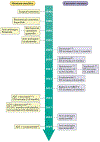Cellular rewiring in lethal prostate cancer: the architect of drug resistance
- PMID: 32203305
- PMCID: PMC7218925
- DOI: 10.1038/s41585-020-0298-8
Cellular rewiring in lethal prostate cancer: the architect of drug resistance
Abstract
Over the past 5 years, the advent of combination therapeutic strategies has substantially reshaped the clinical management of patients with advanced prostate cancer. However, most of these combination regimens were developed empirically and, despite offering survival benefits, are not enough to halt disease progression. Thus, the development of effective therapeutic strategies that target the mechanisms involved in the acquisition of drug resistance and improve clinical trial design are an unmet clinical need. In this context, we hypothesize that the tumour engineers a dynamic response through the process of cellular rewiring, in which it adapts to the therapy used and develops mechanisms of drug resistance via downstream signalling of key regulatory cascades such as the androgen receptor, PI3K-AKT or GATA2-dependent pathways, as well as initiation of biological processes to revert tumour cells to undifferentiated aggressive states via phenotype switching towards a neuroendocrine phenotype or acquisition of stem-like properties. These dynamic responses are specific for each patient and could be responsible for treatment failure despite multi-target approaches. Understanding the common stages of these cellular rewiring mechanisms to gain a new perspective on the molecular underpinnings of drug resistance might help formulate novel combination therapeutic regimens.
Conflict of interest statement
Competing interests
The authors declare no competing interests.
Figures



References
-
- Parker C et al. Alpha emitter radium-223 and survival in metastatic prostate cancer. N. Engl. J. Med 369, 213–223 (2013). - PubMed
-
- Kantoff PW et al. Sipuleucel-T immunotherapy for castration-resistant prostate cancer. N. Engl. J. Med 363, 411–422 (2010). - PubMed
-
- Scher HI Increased survival with enzalutamide in prostate cancer after chemotherapy. N. Engl. J. Med 367,1187–1197 (2012). - PubMed
-
- Smith MR et al. Apalutamide treatment and metastasis-free survival in prostate cancer. N. Engl. J. Med 378, 1408–1418 (2018). - PubMed
Publication types
MeSH terms
Grants and funding
LinkOut - more resources
Full Text Sources
Medical
Miscellaneous

